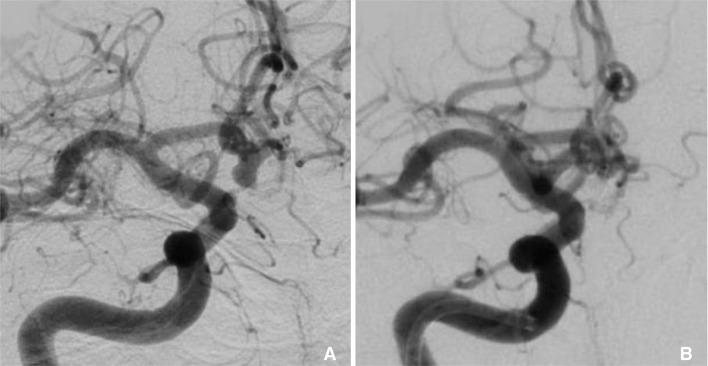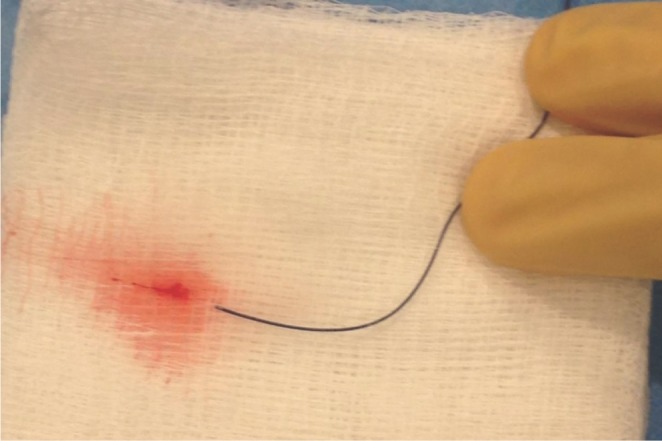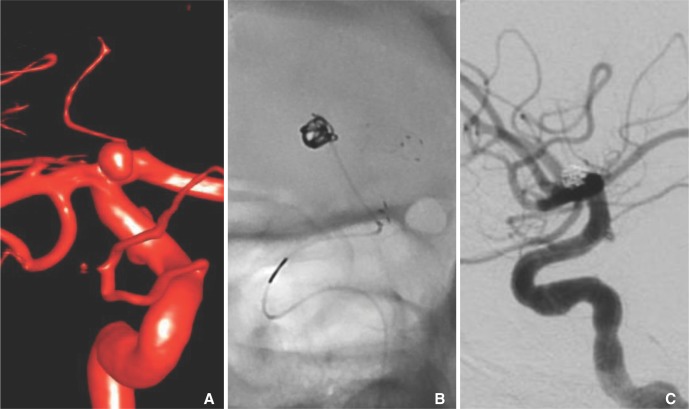Neurointervention.
2014 Feb;9(1):39-44. 10.5469/neuroint.2014.9.1.39.
Aneurysm Coil Embolization Using a 1.5-Fr Distal Outer Diameter Microcatheter
- Affiliations
-
- 1Department of Neurosurgery, Rush University Medical Center, Chicago, IL, USA. Michael_Chen@rush.edu
- KMID: 1910773
- DOI: http://doi.org/10.5469/neuroint.2014.9.1.39
Abstract
- The current assortment of microcatheters widely used for aneurysm coil embolization may not be well suited for several anatomic variants, including excessive vascular tortuosity and small aneurysms less than 3 mm. Longer microcatheters designed with a smaller caliber that can accommodate and deliver coils may be of use in these situations. This case series and literature review illustrates the advantages and limitations of the Marathon microcatheter (Covidien, Irvine, CA, USA) when used for coil embolization of cerebral aneurysms. Despite some technical compromises including the distal marker, length, and the risk of buckling, the Marathon microcatheter was able to adequately deliver coils to achieve satisfactory occlusion of cerebral aneurysms. We found unique advantages with regards to length and smaller distal outer diameter (OD). These results may serve as a guide for the further development of a microcatheter used for coil embolization that has the features of a smaller distal OD and longer length.
Figure
Reference
-
1. Mascitelli JR, Polykarpou MF, Patel AA, Kamath AA, Moyle H, Patel AB. Initial experience with Penumbra Coil 400 versus standard coils in embolization of cerebral aneurysms: a retrospective review. J Neurointerv Surg. 2013; 5:573–576. PMID: 22993243.
Article2. Zoarski GH, Mathis JM, Hebel JR. Performance characteristics of microcatheter systems in a standardized tortuous pathway. AJNR Am J Neuroradiol. 1998; 19:1571–1576. PMID: 9763396.3. Blanc R, Piotin M, Mounayer C, Spelle L, Moret J. Direct cervical arterial access for intracranial endovascular treatment. Neuroradiology. 2006; 48:925–929. PMID: 17102976.
Article4. Horie N, Hayashi K, Morikawa M, Nagata I. Selective coil embolization through flow-directed microcatheter for intracranial arteriovenous malformations. Acta Neurochir (Wien). 2012; 154:989–991. PMID: 22362047.
Article5. Kiyosue H, Hori Y, Matsumoto S, Okahara M, Tanoue S, Sagara Y, et al. Shapability, memory, and luminal changes in microcatheters after steam shaping: a comparison of 11 different microcatheters. AJNR Am J Neuroradiol. 2005; 26:2610–2616. PMID: 16286410.6. Doerfler A, Wanke I, Egelhof T, Dietrich U, Asgari S, Stolke D, et al. Aneurysmal rupture during embolization with Guglielmi detachable coils: causes, management, and outcome. AJNR Am J Neuroradiol. 2001; 22:1825–1832. PMID: 11733309.
- Full Text Links
- Actions
-
Cited
- CITED
-
- Close
- Share
- Similar articles
-
- Microcatheter-assisted Coil Embolization of Distal Vertebral Artery Wide-Necked Aneurysm: A Case Report
- Endovascular Rescue Method for Undesirably Stretched Coil
- Manual Aspiration Technique to Retrieve a Prematurely Detached Coil during Cerebral Aneurysm Embolization
- Acute frame coil migration during filling coil retrieval in a cerebral aneurysm embolization case: A possible result of a venturi effect?
- Open-cell Stent Deployment across the Wide Neck of a Large Middle Cerebral Aneurysm Using the Stent Anchor Technique






